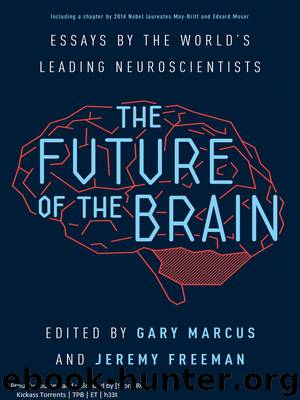The Future of the Brain by Marcus Gary Freeman Jeremy

Author:Marcus, Gary, Freeman, Jeremy [Marcus, Gary, Freeman, Jeremy]
Language: eng
Format: epub
Publisher: Princeton University Press
Published: 2014-01-07T14:00:00+00:00
Some Promising Directions: Correlational Examples, with Explanatory Ambitions
Syntactic Primitives
The goals of syntactic research over the last twenty years align well with the goals of cognitive and systems neuroscience (for example, in work on computational vision, see chapter by Carandini): to identify fundamental neuronal computations that (i) underlie a large number of (linguistic) phenomena, and (ii) rely as little as possible on domain-specific properties. As a concrete example, the syntactic theory known as minimalism, developed by Chomsky and others, has formulated a two-step syntactic function called “Merge” (see above re concatenation) that separates into a domain-general computation that combines elements (somewhat akin to binding, in the context of systems neuroscience), and a probably more domain-specific computation that labels the output of the binding computation:
(1) Bind: Given an expression A and an expression B, bind A,B → {A,B}
(2) Label: Given a combined {A,B}, label the complex A or B; → {A A,B} or {B A,B}
Recent work in linguistics suggests that many of the complex properties of natural languages can be modeled as repeated applications of these Bind and Label computations. Furthermore, the formal characterization of these computations in set-theoretic terms provides a computational-level description similar to the formal characterization of neuronal computations in other domains of cognition (for example, normalization functions in vision). This new direction in syntactic theory marks a radical departure from earlier theories, which contained a large number of disparate kinds of rules and relied heavily on domain-specific properties of those rules. The time seems right for a renewed collaboration between syntacticians and cognitive/systems neuroscientists, teaming up to search for the neural circuits that subserve fundamental syntactic computations like Concatenate/Combine/Bind and Label, and ultimately the neuronal encoding of the computations themselves. Cognitive and systems neuroscientists who were dissuaded by the many rules of earlier syntactic theories may be heartened to learn that linguists have already begun to reformulate syntactic theories in terms of (putative) fundamental neuronal computations.
Speech Perception and Cortical Oscillations: Emerging Computational Principles
Recognizing spoken language requires parsing or chunking relatively continuous input into discrete units that can connect with the stored information that forms the basis for processing, or informally, words. In addition to such a parsing stage, there must also exist a decoding stage in which parsed acoustic information is transformed into representations that underpin linguistic computation. In the last decade, functional anatomic and physiological studies have identified the infrastructure of the language-ready brain. In particular, the functional anatomy of speech sound processing is comprised of a distributed cortical system encompassing regions along (at least) two streams. A ventral, temporal lobe pathway provides the substrate to map from sound input to meaning/words. A dorsal path along parietal and frontal lobes allows for the sensorimotor transformations that underlie the mapping to output representations.
Speech contains information (required for successful decoding) that is carried at multiple timescales: intonation-level information at the scale of 500–1,000 ms; syllabic information closely correlated to the acoustic envelope of speech at the scale of 150–300 ms; and rapidly changing featural (and phonemic) information at the scale ~20–80 ms.
Download
The Future of the Brain by Marcus Gary Freeman Jeremy.epub
This site does not store any files on its server. We only index and link to content provided by other sites. Please contact the content providers to delete copyright contents if any and email us, we'll remove relevant links or contents immediately.
| Anatomy | Animals |
| Bacteriology | Biochemistry |
| Bioelectricity | Bioinformatics |
| Biology | Biophysics |
| Biotechnology | Botany |
| Ecology | Genetics |
| Paleontology | Plants |
| Taxonomic Classification | Zoology |
Sapiens: A Brief History of Humankind by Yuval Noah Harari(14247)
The Tidewater Tales by John Barth(12608)
Mastermind: How to Think Like Sherlock Holmes by Maria Konnikova(7223)
Do No Harm Stories of Life, Death and Brain Surgery by Henry Marsh(6887)
The Thirst by Nesbo Jo(6826)
Why We Sleep: Unlocking the Power of Sleep and Dreams by Matthew Walker(6618)
Life 3.0: Being Human in the Age of Artificial Intelligence by Tegmark Max(5474)
Sapiens by Yuval Noah Harari(5293)
The Longevity Diet by Valter Longo(5017)
The Body: A Guide for Occupants by Bill Bryson(4973)
The Rules Do Not Apply by Ariel Levy(4846)
The Immortal Life of Henrietta Lacks by Rebecca Skloot(4525)
Animal Frequency by Melissa Alvarez(4394)
Why We Sleep by Matthew Walker(4358)
The Hacking of the American Mind by Robert H. Lustig(4318)
Yoga Anatomy by Kaminoff Leslie(4303)
All Creatures Great and Small by James Herriot(4230)
Double Down (Diary of a Wimpy Kid Book 11) by Jeff Kinney(4204)
Barron's AP Biology by Goldberg M.S. Deborah T(4095)
